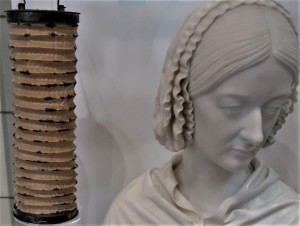A Happier, Healthier World

Help Us Live in a Happier, Healthier World.
Pioneer nurse Florence Nightingale sculpture and the paper lantern she carried at Scutari, ca. 1855. (National Army Museum Collection, London).
(P. Ferguson image, November 2019)
World Health Day
The sound of birds twittering greets my morning as I open the sliding door to take in this day’s good air. It is cool but the warmth of the sun will soon lift our spirits by late afternoon. Throughout the day’s hours the birds continue with their dance fluttering tree to tree in search of companions. It is a good day…spring is upon us.
With the day I receive the early morning news that informs me this day, 7 April 2020, is World Heath Day, a celebration honouring the founding of the World Health Organization. This year’s theme: Nurses and Midwives: Help Us Live in a Happier, Healthier World…Take a minute to say thank you.
Respective of the day I turn to a nurse and voluntary aid detachment member of the 1940 Blitz sharing with you their two stories of courage. Both women represent different capacities of nurse training, V.A.D. Dorothy White who, though having received medical training, was not a fully qualified nurse and Mary Newman a qualified assistant nurse. Both women provided nursing care above and beyond their normal day.
Miss Dorothy May White
Awarded the George Medal
Voluntary Aid Detachment
British Red Cross Society, Horsham and Worthing, England
Village Hall at Colgate, near Horsham, Sussex
9 September 1940
During an air raid V.A.D. White, together with two other V.A.D.s was on duty at the First Aid point at the Village Hall. While there an H.E. (High Explosive) bomb was dropped on the District Nurse’s cottage next door, completely demolishing it. The three V.A.D.s immediately went to the Nurse’s help. They found her in the crater which had been the cottage, lying head downwards, alive but badly injured. The three V.A.D.s with great difficulty, on account of the depth of the crater and the loose rubble lifted the nurse out on to a stretcher, and carried her to the Village Hall.
While the other two V.A.D.s were doing all they could for the District Nurse. V.A.D. White went to the further end of the Hall to get some water. While there a bomb fell directly on to the Hall, demolishing the end where the injured Nurse lay, killing her, fatally injuring one of the V.A.D.s and severely injuring the other.
With no thought for herself V.A.D. White scrambled over the debris and found the two injured members partly covered by fallen rubble. She immediately gave first aid wit the help of a tourniquet made from her belt. All dressings and equipment had been buried by the explosion. She got one onto an ambulance with the assistance of the Police.
V.A.D. White then went down the road to help other casualties, and visited all the cottages in the village to find out whether anyone else was missing and if anyone needed attention.
Assistant Nurse Miss Mary Sible Joyce Newman
Awarded the George Medal
Borough Medical Services
A house in Cypress Avenue, Bitterne, Southampton
23 November 1940
When an H.E. (High Explosive) bomb struck two houses the four occupants of one were killed outright. In the other a man was blown out through the front door and into the road. Nurse Newman attended to his injuries. A search was then made of the wrecked house and his son was found suspended almost upside down, and held by his ankles. He was in an extremely excitable condition, and whilst rescue work was being attempted, Nurse Newman, in spite of debris falling all around, and in the presence of escaping gas from a fractured main, crawled into the aperture to comfort and quieten the casualty. Several times she almost collapsed in the poisoned atmosphere, but carried on and the boy was eventually released suffering from severe shock. Nurse Newman then applied first aid until an ambulance took him to hospital. By her actions and admirable coolness and courage she inspired others to continue with the rescue work.

Comments